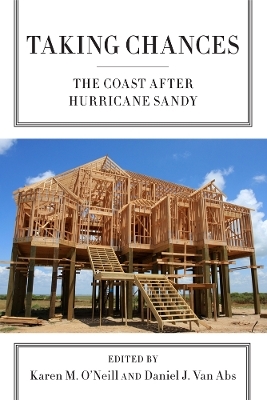
Taking Chances
Rutgers University Press (Verlag)
978-0-8135-7376-2 (ISBN)
Humanity is deeply committed to living along the world’s shores, but a catastrophic storm like Sandy—which took hundreds of lives and caused many billions of dollars in damages—shines a bright light at how costly and vulnerable life on a shoreline can be. Taking Chances offers a wide-ranging exploration of the diverse challenges of Sandy and asks if this massive event will really change how coastal living and development is managed. Bringing together leading researchers—including biologists, urban planners, utilities experts, and climatologists, among others—Taking Chances illuminates reactions to the dangers revealed by Sandy. Focusing on New Jersey, New York, and other hard-hit areas, the contributors explore whether Hurricane Sandy has indeed transformed our perceptions of coastal hazards, if we have made radically new plans in response to Sandy, and what we think should be done over the long run to improve coastal resilience. Surprisingly, one essay notes that while a large majority of New Jerseyans identified Sandy with climate change and favored carefully assessing the likelihood of damage from future storms before rebuilding the Shore, their political leaders quickly poured millions into reconstruction. Indeed, much here is disquieting. One contributor points out that investors scared off from further investments on the shore are quickly replaced by new investors, sustaining or increasing the overall human exposure to risk. Likewise, a study of the Gowanus Canal area of Brooklyn shows that, even after Sandy swamped the area with toxic flood waters, plans to convert abandoned industrial lots around the canal into high-density condominiums went on undeterred. By contrast, utilities, emergency officials, and others who routinely make long-term plans have changed operations in response to the storm, and provide examples of adaptation in the face of climate change. Will Sandy be a tipping point in coastal policy debates—or simply dismissed as a once-in-a-century anomaly? This thought-provoking collection of essays in Taking Chances makes an important contribution to this debate.
KAREN M. O’ NEILL is an associate professor in the department of human ecology at Rutgers University in New Brunswick, New Jersey. She is the author of Rivers by Design: State Power and the Origins of U.S. Flood Control and she co-edited Katrina’s Footprint: Race and Vulnerability in America (Rutgers University Press). DANIEL J. VAN ABS is an associate professor of practice in the department of human ecology at Rutgers University in New Brunswick, New Jersey. He is the coauthor of Water Infrastructure in New Jersey’s CSO Cities: Elevating the Importance of Upgrading New Jersey’s Urban Water Systems.
AcknowledgmentsIntroduction: A Transformational Event, Just Another Storm, or Something in Between?Karen M. O’Neill, Daniel J. Van Abs, and Robert B. GramlingPart One: The StormChapter 1: Hurricane Sandy from Meteorological and Climatological PerspectivesSteven G. Decker and David A. RobinsonChapter 2: A Tough Move to Make: Lessons Learned from Emergency Evacuations in Coastal Connecticut during Hurricane SandyDaniel Baldwin Hess and Brian W. ConleyPart Two: The Days after the StormChapter 3: Overlooked Impacts of Hurricane Sandy in the CaribbeanAdelle ThomasChapter 4: Polling Post-Hurricane Sandy: The Transformative Personal and Political Impact of the Hurricane in New JerseyAshley A. Koning and David P. RedlawskChapter 5: Ecological Injury and Responses to Hurricane Sandy: Physical Damage, Avian and Food Web Responses, and Anthropogenic Attempts to Aid Ecosystem Recovery in New Jersey EstuariesJoanna Burger and Larry NilesChapter 6: Surviving Sandy: Identity and Cultural Resilience in a New Jersey Fishing CommunityAngela Oberg, Julia A. Flagg, Patricia M. Clay, Lisa L. Colburn, and Bonnie McCayPart Three: Planning for Change?Chapter 7: Green Gentrification and Hurricane Sandy: The Resilience of the Green Growth Machine around Brooklyn’s Gowanus CanalKenneth A. Gould and Tammy L. LewisChapter 8: Boardwalks Reborn: Disaster and Renewal on the Jersey ShoreMark Alan HewittChapter 9: A Sure/Shore Thing? Tourism Recovery in New York and New Jersey after Hurricane SandyBriavel HolcombChapter 10: Local Fiscal Impacts of Hurricane SandyClinton J. AndrewsChapter 11: Local Responses to Hurricane Sandy: Heterogeneous Experiences and Mismatches with Federal PolicyMariana Leckner, Melanie McDermott, James K. Mitchell, and Karen M. O’NeillChapter 12: Water Utilities: Storm Preparedness and RestorationDaniel J. Van AbsChapter 13: Impact of Extreme Events on the Electric Power Sector: Challenges, Vulnerabilities, Institutional Responses, and Planning Implications from Hurricane SandyFrank A. Felder and Shankar ChandramowliConclusion: Emerging Responses to Life on the Urbanized Coast after Hurricane SandyDaniel J. Van Abs and Karen M. O’NeillNotes on ContributorsIndex
| Erscheinungsdatum | 19.05.2016 |
|---|---|
| Co-Autor | Robert B. Gramling, Steven G. Decker, David A. Robinson |
| Zusatzinfo | 10 photographs, 14 maps, 11 fi |
| Verlagsort | New Brunswick NJ |
| Sprache | englisch |
| Maße | 152 x 229 mm |
| Themenwelt | Naturwissenschaften ► Biologie ► Ökologie / Naturschutz |
| Naturwissenschaften ► Geowissenschaften ► Geografie / Kartografie | |
| Sozialwissenschaften ► Politik / Verwaltung ► Staat / Verwaltung | |
| Sozialwissenschaften ► Soziologie | |
| Technik ► Bauwesen | |
| Technik ► Umwelttechnik / Biotechnologie | |
| Wirtschaft ► Betriebswirtschaft / Management ► Rechnungswesen / Bilanzen | |
| ISBN-10 | 0-8135-7376-9 / 0813573769 |
| ISBN-13 | 978-0-8135-7376-2 / 9780813573762 |
| Zustand | Neuware |
| Haben Sie eine Frage zum Produkt? |
aus dem Bereich


